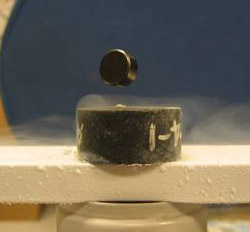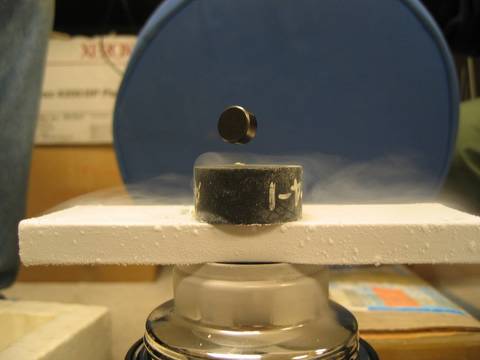Landmarks: Superconductivity Explained
APS has put the entire Physical Review archive online, back to 1893. Focus Landmarks feature important papers from the archive.
In 1957, the Physical Review published the first fundamental theory explaining how, at low temperatures, some materials can conduct electricity entirely without resistance. Building on experimental clues and earlier theoretical hints, John Bardeen, Leon Cooper, and Robert Schrieffer, all at the University of Illinois in Urbana, explained not just the absence of electrical resistance but also a variety of magnetic and thermal properties of superconductors. The “BCS” theory also had an important influence on theories of particle physics and provided the starting point for many attempts to explain the new high-temperature superconductors.
Superconductivity was discovered in 1911, and by the 1930s, physicists had concluded that electrons in a superconductor must occupy a quantum-mechanical state distinct from that of normal conduction electrons. In 1950, researchers found that the temperature at which mercury becomes a superconductor is slightly higher for mercury isotopes of lower atomic weight, suggesting that superconductivity somehow involves motion of the atoms in a material as well as the electrons.
Following up on this “isotope effect,” Bardeen and Illinois colleague David Pines showed theoretically that within an atomic lattice, electrons could attract one another, despite their strong electrostatic repulsion. Essentially, an electron can create vibrations among the lattice atoms, which can in turn affect other electrons, so the attraction is indirect.
By the middle 1950s, Bardeen was collaborating with Cooper, a post-doctoral fellow, and Schrieffer, a graduate student. Cooper published a short paper showing how the Bardeen-Pines attraction could cause electrons with opposite momentum to form stable pairs [1]. This pairing mechanism, Cooper suggested, might be responsible for superconductivity, but Bardeen was initially skeptical. The paired electrons were not physically close together but moved in a coordinated way, always having equal but opposite momentum. It was not clear that these tenuous, extended pairs could be crammed together to create a superconducting medium without getting disrupted.
A few months later, however, Schrieffer hit on a mathematical way of defining a quantum mechanical state containing lots of paired electrons, with the pairs oblivious to other electrons and the lattice, allowing them to move without hindrance. He later compared the concept to the Frug, a popular dance at the time, where dance partners could be far apart on the dance floor, separated by many other dancers, yet remain a pair [2].
After publishing a short note early in 1957 [3] the team published what became known as the Bardeen-Cooper-Schrieffer, or BCS, theory of superconductivity in December. They won the Nobel prize in 1972. The theory explained the isotope effect and the fact that magnetic fields below a certain strength cannot penetrate superconductors. It also explained why superconductivity could only occur near absolute zero–the tenuous Cooper pairs break up in the presence of too much thermal jiggling. It’s a testament to Bardeen’s insight that he chose the right collaborators and kept his eye on experiment in seeing the way forward, says superconductivity experimentalist Laura Greene of the University of Illinois: “It’s how science should be done.”
One oddity of the BCS wave function is that it lacks some of the mathematical symmetry expected at the time for any quantum or classical solution of electromagnetic equations. Further analysis of this point spurred the development of so-called symmetry breaking theories in particle physics.
Although the superconductors discovered in 1986 rely on electron pairing, they remain superconducting at temperatures above what the pairing mechanism in BCS can easily explain. But Marvin Cohen of the University of California at Berkeley says that given the poor understanding of the new materials, the original BCS pairing mechanism shouldn’t be ruled out. And, adds Greene, it took “some very smart people” almost 50 years to get from the discovery of superconductivity to BCS, so she’s not worried that the high temperature superconductors remain unsolved after a mere 20 years.
–David Lindley
David Lindley is a freelance science writer in Alexandria, Virginia.
References
- Leon N. Cooper, “Bound Electron Pairs in a Degenerate Fermi Gas,” Phys. Rev. 104, 1189 (1956)
- Lillian Hoddeson and Vicki Daitch, True Genius: The Life and Science of John Bardeen, (Joseph Henry Press, 2002), p. 203
- J. Bardeen, L. N. Cooper, and J. R. Schrieffer, “Microscopic Theory of Superconductivity,” Phys. Rev. 106, 162 (1957)
More Information
Further reading: Lillian Hoddeson and Vicki Daitch, True Genius: The Life and Science of John Bardeen, (Joseph Henry Press, 2002)





